|
The years in which the Fiat 500 was in
production (1957-1975) were some of the most important in
the 20th century. Apart from major events and history with a
capital ‘H’, the overall evolution in living conditions and
lifestyles was constant. Numerous objects that we now use
regularly and which appear absolutely banal, such as
felt-tip pens or colour photocopiers, even colour
television, or the now almost obsolete VHS video tapes or
music cassettes, soft contact lenses, resin teeth and safety
attachments for skis, were invented, developed or produced
in the 18 years in which the various series and versions of
the 500 were eating up the miles on roads in Italy and
elsewhere.
The 500 debuted in 1957, when the first episodes of the
Carosello programme were broadcast on Italian television,
and was retired in 1975, when the first pioneering VHS video
recordings were appearing. In its 18 years of life, it
survived a whole epoch. For example, when it was presented,
the USSR launched the Sputnik into space carrying a small
dog, Laika, the first living being to orbit the Earth. It
was the age of the conquest of space, but then, the 500
helped to conquer mobility in Italy. And talking of Italy,
we have to mention sport: in 1957, AC Milan won the soccer
Championship, and Gastone Nencini of Tuscany won the Giro
d’Italia. Jacques Anquetil won his first Tour de France and
Juan Manuel Fangio the last of his five F1 world titles with
Maserati. The Mille Miglia had been cancelled because of the
terrible accident in Guidizzolo (ten dead, including the
driver De Portago).
Italian television in 1957 did not only
broadcast Carosello, but also ‘Il Musichiere’ with Mario
Riva and ‘Lascia o Raddoppia’ presented by Mike Bongiorno.
At the cinema, the big films were the Swedish ‘Wild
strawberries’ with Ingrid Thulin and ‘A King in New York’
with Charlie Chaplin. West Side Story debuted on stage in
the USA, with music by Leonard Bernstein, and Italian
bookstores offered Pasternak’s ‘Doctor Zhivago’, ‘Quer
pasticciaccio brutto de via Merulana’ by Carlo Emilio Gadda,
‘Il Barone rampante’ by Italo Calvino and ‘L’isola di
Arturo’ by Elsa Morante. 1957 was also an eventful year
politically. In Rome, Italy, France, the German Federal
Republic, Belgium, the Netherlands and Luxembourg signed the
treaties that founded the European Economic Community, which
was to produce the European Common Market in 1958.
1958, the year of the 500 Sport, was certainly no less
intense than the previous year. Vladimir Nabokov published
his novel ‘Lolita’ in the United States, which caused a
scandal and created a new word. In Italy, ‘Il Gattopardo’ by
Giuseppe Tomasi di Lampedusa was published posthumously, and
in London, Graham Greene brought out ‘Our Man in Havana’.
And the boom of the American beat generation continued.
There were news items that went almost unnoticed although
they were extremely important. For example, Swedish doctor
Ake Senning invented the cardiac stimulator or pacemaker.
The first high-speed dentists’ drills made a little more
noise, but were less painful. The American Ampex company
announced the arrival of a video colour recorder. And
‘ampex’ also joined our vocabulary, at least in the world of
television media.
The race to nuclear propulsion picked up
speed, literally. The USA and USSR launched ‘atomic’
transport and icebreaker ships, and the US Navy submarine
the Nautilus passed under the polar icecap. A young
ballerina, Carla Fracci, became an étoile at La Scala in
Milan, and Giancarlo Menotti founded the Festival of the Two
Worlds in Spoleto. In sport, Brazil won the World Cup in
Sweden, Juventus won the Italian soccer championship, Ercole
Baldini won the Giro d’Italia and a climber, Charly Gaul
from Luxembourg, won the Tour de France. Pope Pius XII,
Eugenio Pacelli, died in 1958 and Angelo Roncalli was
elected Pope John XXIII, Khrushchev became Soviet Premier
and Communist Party Chairman, and General De Gaulle was
elected President of the 5th French Republic. In Algeria,
generals Salan and Massu attempted a coup to try to prevent
the process of independence in the North African country.
In 1959 Fulgencio Batista fled from Cuba and Fidel Castro
came to power, Cyprus declared independence and a revolt in
Tibet was put down by Chinese troops as the Dalai Lama found
refuge in India. Alaska and Hawaii became the 49th and 50th
states of the USA. Great books like ‘La suora giovane’ by
Giovanni Arpino, ‘Una vita violenta’ by Pier Paolo Pasolini,
and ‘The Tin Drum’ by German Günter Grass reached the
bookstores, the Astérix comics debuted in France, and cinema
audiences watched ‘Hiroshima mon amour’ by Alain Resnais and
‘Some like it hot’ with Marilyn Monroe and Jack Lemmon,
directed by Billy Wilder. In sport, Gaul won the Giro
d’Italia, the Spanish rider Bahamontes won the Tour de
France and Milan won the Italian scudetto, which was
reclaimed by the Juventus of Boniperti, Charles and Sivori
in 1960 and 1961.
The 500 D and the Giardiniera were launched in 1960, the
year of the Rome Olympics. The sports year ended with the
death of Fausto Coppi. John Kennedy won the US presidential
elections and a crisis immediately started with the USSR
when the U2 spy plane was shot down. Economic relations with
Cuba were interrupted, and in South Vietnam, the Vietcong
guerrilla forces attacked the Diem government and the
Americans who supported it. 1960 was also the year of the
first performances by the Beatles in Liverpool, and the
birth of the Hippy movement in American universities. Pop
art spread through the world, and new books included ‘La
ragazza di Bube’ by Carlo Cassola, and ‘Il Vizio assurdo’, a
biography of Cesare Pavese by Davide Layolo. ‘Rocco e i suoi
fratelli’ directed by Luchino Visconti reached the cinemas.
The general census of 1961 found that there were 50,624,000
Italians. During the year, the first audio cassettes were
manufactured. The WWF was founded, and Briton Peter Benenson
founded ‘Amnesty International’ in the field of human
rights. 1961 went down in history for a number of dramatic
events. Construction of the Berlin Wall began during the
year, while in Cuba, the anti-Castro Bay of Pigs expedition
supported by the CIA was a failure. The USSR announced that
it was carrying out nuclear experiments again. In the
meantime, France was trying to deal with the OAS terrorists
who wanted to maintain colonial domination in Algeria. In
the culture field, Leonardo Sciascia published ‘Il giorno
della civetta’, and Ernest Hemingway and Italian painter
Mario Sironi both died. Pier Paolo Pasolini directed ‘L’accattone’,
Francesco Rosi directed ‘Salvatore Giuliano’, and
Michelangelo Antonioni ‘La notte’, which starred Monica
Vitti.
In 1962, the electricity board in Italy was nationalised,
and Enel was created; the first centre-left government came
to power (the DC, PSDI and PRI with the external support of
the PSI, while the PLI went over to the Opposition). The II
Vatican Council opened, France gave up Algeria which became
independent. The Cuban crisis exploded and the world was one
step from nuclear war and, as if that were not enough, China
launched a partial invasion of India. In the meantime a
German, Walter Bruch, developed the PAL colour television
system, the American satellite Telstar made the first global
transmission in colour possible, and the first industrial
robots were built in Japan. Where culture is concerned, ‘Il
giardino dei Finzi Contini’ by Giorgio Bassani, and ‘Il
piatto piange’ by Piero Chiara were published. There was
also a book with the unusual title of ‘A Clockwork Orange’
by British writer Anthony Burgess, made into a film by
Stanley Kubrick. The Russian dissident Alexander
Solzhenitsyn, succeeded in publishing ‘One day in the life
of Ivan Denisovich’ abroad. The Rolling Stones were founded
in Britain and ‘Dr. No’, the first film in the Bond series,
was released. The stylist and poster designer Marcello
Dudovich died, the author of some of the loveliest 20th
century Italian posters. And Marilyn Monroe committed
suicide in the USA.
Giovanni XXIII, the ‘good Pope’, died and in 1963 Giovan
Battista Montini was elected Paul VI. 1963 was a year of
mourning, with the Vajont dam disaster (over 2000 dead) and
the assassination of Kennedy in Dallas. In Italy, the
centre-left Government was reshuffled yet again, and the
cultural scene was very lively. ‘Lessico familiare’ by
Natalia Ginsburg and ‘La tregua’ by Primo Levi were
published, and the Campiello prize was founded in Venice.
‘The life of Galileo’ by Brecht was a success in Milan
starring Tino Buazzelli, and Federico Fellini’s ‘Otto e
mezzo’ reached the cinema, but the box office hit of the
year was certainly ‘Il Gattopardo’. The great Edith Piaf and
the Italian painter Felice Casorati died. In the middle of
all these events there was one that changed our lives
(certainly not the space flight of Soviet Cosmonaut
Tereskova or the experimentation with synthetic resin teeth
in the USA or the introduction of middle school for everyone
in Italy): the first acrylic felt tips were produced. Nikita
Khrushchev fell from power in Russia, replaced by Leonid
Brezhnev as Communist Party secretary and Alexey Kosygin as
Prime Minister. Palmiro Togliatti, secretary of the Italian
Communist Party, died in Yalta (USSR).
Early in 1964 France recognised Red China and the USA began
to bomb North Vietnam. China exploded its first atom bomb
and the PLO (Palestine Liberation Organisation) was founded
in Jerusalem. That year the Milan – Naples stretch of the
Autostrada del Sole (755 km) was terminated, the Milan
underground railway was inaugurated and ‘A fistful of
dollars’ by Sergio Leone, the first archetypal ‘spaghetti’
Western, reached the cinemas. A Czechoslovak technician
produced the first soft contact lenses and in Germany,
biodegradable detergents became obligatory.
|
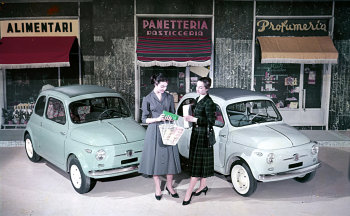
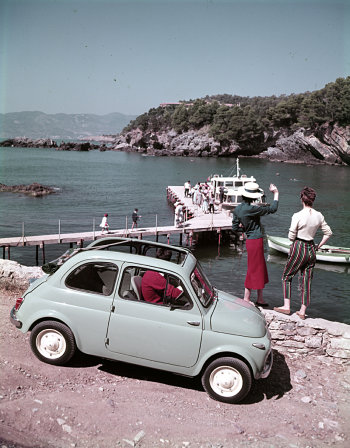
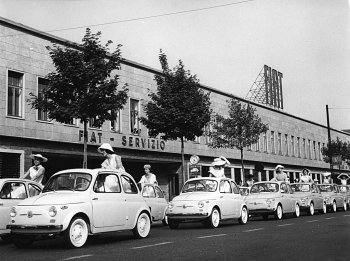 |
|
The 500 debuted in 1957, when the first episodes of the
Carosello programme were broadcast on Italian television,
and was retired in 1975, when the first pioneering
VHS video recordings were appearing. |
|
|
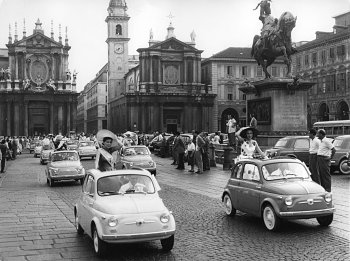
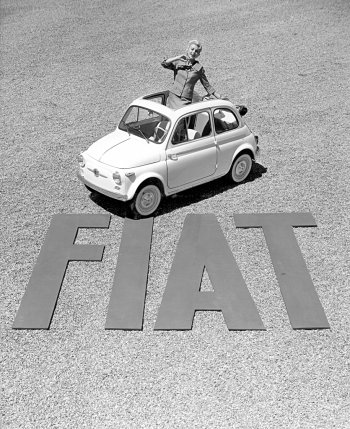
 |
|
The years in which the Fiat 500 was in production
(1957-1975) were some of the most important in the
20th century. Apart from major events and history
with a capital ‘H’, the overall evolution in living
conditions and lifestyles was constant. |
|
|
Dario Fo
published ‘Settimo ruba un po’ meno’, Marcuse published
‘One-dimensional man’, Pasolini directed ‘Il vangelo secondo
Matteo’ and, finally, the first works by Bulgarian sculptor
Christo Javacheff appeared. The first work was called ‘Table
with packaged object’.
In 1965 the 500 F made its debut, while the Cultural
Revolution was starting in China, Mary Quant was launching
the miniskirt in Britain, and the vernacular was replacing
Latin in the Catholic liturgy. The mention of these three so
different events (combined with the launch of another
version of the small Fiat) underlined the many changes that
took place in 1965. From the marketing of the first
video-recorders right up to the construction of the first
electronic music synthesisers and the launch of the first
telecommunications satellite. Tragic events for the year
included the race riots in Los Angeles, the assassination of
Malcolm X, a new war between India and Pakistan, and
guerrilla attacks on Israel by the PLO and Al-Fatah. Cinema
audiences watched ‘I pugni in tasca’ by Belloccio, while ‘Le
cosmicomiche’ by Calvino reached the bookstores. In the
sports field, the triumph of a young Felice Gimondi at the
Tour de France was a cause for celebration.
In 1966, Indira Gandhi was elected Prime Minister of India,
while the Red Guards were created in China to support the
Cultural Revolution. It was the year that the Americans
bombed Hanoi, and that De Gaulle decided to take France out
of NATO. Truman Capote published ‘In cold blood’, Giuseppe
Berto ‘La cosa buffa’, Gabriel Garcia Marquez ‘One hundred
years of solitude’, and Jorge Amado ‘Dona Flor and her Two
Husbands’, while Bulgakov’s ‘The Master and Margarita’ was
published posthumously. In the field of ‘small’ things that
were anything but small: the French manufacturer Salomon
produced and marketed the first safety attachments for
downhill skis. The home team won the World Cup in England,
and it is the only Rimet Cup ever won by the country that is
the home of football. Italy was sent home by North Korea and
a goal by an unknown dentist lent to the national team
called: Pak Doo Ik.
The 6 Day war between Israel and Egypt, Jordan and Syria,
during which the Israeli army occupied the Golan Heights,
Sinai, the West Bank and Jerusalem set the Summer of 1967
alight. That same year there was a military coup in Greece,
and Ernesto Che Guevara was killed in Bolivia by government
troops. 1967 was a difficult year, in which the UN
calculated that the world population was about 3 billion 420
million people. Where improvements to the quality of life
are concerned, Dolby patented a system to reduce background
noise, scintigraphy became an accepted diagnostic method and
South African Christian Barnard carried out the first human
heart transplant. ‘Hair’ was staged for the first time in a
theatre off Broadway, and cinema audiences saw ‘Belle de
Jour’ by Luis Buñuel and ‘Blow up’ by Michelangelo
Antonioni.
The Fiat 500 L was launched in 1968, like the first colour
television patented by Sony, the Trinitron. That year Italy
was also involved in the huge project to dismantle and
reassemble the Abu Simbel temples, threatened by the
construction of the Aswan dam. Eugenio Monti and Franco
Nones won gold at the Winter Olympics in Grenoble, and the
Italian soccer team won the European title. But the year was
remembered for the events in France: ‘May ‘68’. With the
slogan ‘Power to the Imagination’, student movements all
over Europe rose up to try to shake up a society that was
out of date. That same year Martin Luther King and Robert
Kennedy were assassinated, the violence of the Vietnam war
increased, Czechoslovakia was invaded by Russian troops to
wipe out the new liberal political environment created by
Dubcek. In the USA, Richard Nixon was re-elected President.
In Italy, a disastrous earthquake hit the Belice Valley.
Beppe Fenoglio published ‘Il partigiano Johnny’, and
Kubrik’s ‘2001: A Space Odyssey’ hit the cinemas.
Man’s landing on the moon was the event that symbolises
1969. By itself. It was sufficient to represent a year
characterised by Concorde’s first flight, or the Woodstock
pop festival in the USA, depending on one’s taste. For
cinema lovers, it was the year of ‘Easy Rider’ by Dennis
Hopper, ‘Zabriskie Point’ by Michelangelo Antonioni, and
‘The damned’ by Luchino Visconti. The first peace
negotiations between USA and North Vietnam were held in
Paris during the year, and Ho Chi Mihn died in Hanoi. Yasser
Arafat was elected President of the PLO, and in France De
Gaulle resigned and was replaced by Georges Pompidou. A
military coup in Libya removed King Idris, and colonel
Gaddafi seized power.
1970 was a ‘full’ year, starting with the great Italian
soccer team that was runner-up at the World Cup Mexico ’70
behind the supreme Brazilians. American bombing raids
started again in Vietnam, Nasser died and Khmer Rouge
guerrilla warfare began in Cambodia. Divorce was introduced
in Italy. The list of ‘positive events’ for the year
included the first regular flights of the Boeing 747 jumbo
jet and the first cassette video recorders on the market.
Eric Segal had a global success with his tear-jerker ‘Love
Story’, and the new fashion for ‘body art’ caused dissent in
the USA and elsewhere.
Bangladesh was created out of the former East Pakistan. This
was one of the events of 1971, the year in which a popular
referendum gave women the vote in Switzerland. In Uganda,
Idi Amin, the ‘cannibal’, seized power. China obtained a
permanent seat on the UN Security Council. The same year,
French fashion designer Coco Chanel died. In California,
biochemist Chob Hao Li synthesised the growth hormone, and
the CAT scan diagnostic procedure was refined. The moon
landings continued and the American Apollo 15 astronauts
actually drove around on the moon in a special vehicle.
1972 was the year of the last series of the Fiat 500, the R.
In the Spring, Luigi Berlinguer was elected secretary of the
Italian Communist Party, Richard Nixon made a historic
journey to China, and Italian President Giovanni Leone
dissolved Parliament in advance for the first time in the
history of the Italian Republic. But the most shocking event
in 1972 was the murder of the Israeli athletes at the Munich
Olympics. And the Watergate scandal broke in the USA. The
interesting events of the year included the marketing of the
first home pregnancy test, and the sale of the first,
extremely expensive, pocket electronic calculators. The
‘Bronzes of Riace’ were rescued from the sea in Calabria,
almost on the same day that a madman attacked Michelangelo’s
Pietà in St. Peter’s with a hammer. Carlo Fruttero and
Franco Lucentini published ‘La donna de la domenica’, and
Bernardo Bertolucci’s film ‘Last tango in Parigi’ was
sequestered for obscenity. The first film of the ‘Godfather’
saga was screened.
In January 1973, the United Kingdom, Ireland and Denmark
joined the European Common Market, and USA and North Vietnam
signed an agreement that envisaged the American withdrawal
from the country and its unification. Also in the USA, the
Senate investigation into Nixon’s role in the Watergate
affair began. In Chile, Salvador Allende was killed during a
coup, and in Argentina Juan Domingo Peron returned to power,
being elected President. The two Germanies joined the United
Nations. The Arab-Israeli Yom Kippur war broke out in
November, and in Spain pro-Franco Prime Minister Carrero
Blanco was assassinated. The OPEC countries approved an
increase in oil prices that had serious repercussions for
Western economies. One positive event was the definitive
abolition of corporal punishment in British schools. New
films included ‘Amarcord’ by Federico Fellini, ‘La grande
bouffe’ by Marco Ferreri, ‘The discreet charm of the
bourgeoisie’ by Buñuel and ‘American Graffiti’. Cinemas,
which were already battling against the spread of Italian
soft porn, were invaded by films full of Chinese martial
arts. And in 1973 the great Pablo Picasso died.
1974 began with the good news that Israel was abandoning the
Suez Canal, thus speeding up the peace process with Sadat’s
Egypt. In Portugal the Carnation Revolution took place,
bringing the Salazar-Caetano era to an end. In Germany,
Willy Brandt resigned as Chancellor when one of his
collaborators was accused of spying for East Germany. Valéry
Giscard d’Estaing was elected President of France, with
Jacques Chirac as Prime Minister. In Greece, the military
regime collapsed, and Cyprus was divided in two, after the
landing of Turkish troops. Nixon faced impeachment following
the Watergate affair and he resigned, being replaced by Vice
President Gerald Ford. In Italy, while the threat of
terrorism from the left and the right increased, a
referendum to abolish divorce was defeated. ‘The Gulag
Archipelago’ by Solzhenitsyn, and ‘Roots’ by Alex Haley
reached the bookstores. Japanese architect Yamasaki began to
design the New York World Trade Center.
1975 was the last year of production of the 500 R. To
understand how much the world had changed in the 18 years
since 1957, we only have to think that in 1975 the VHS
format for video cassettes had become common use, the first
colour photocopier was being mass produced, and a primitive
video-disc was on the market. The American and Soviet
spaceships Apollo and Soyuz linked up in space. In Italy the
voting age was lowered from 21 to 18, another sign of the
changing society.
|
|
|
|